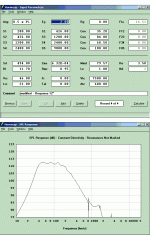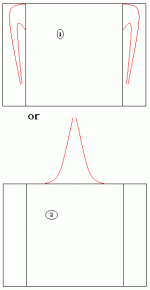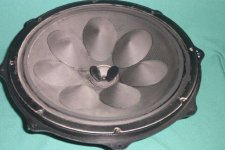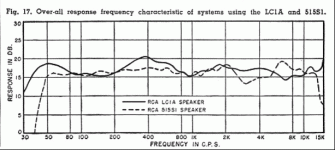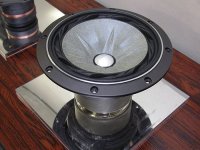Scottmoose said:Don't write off vented alignments, especially EBS tuned very low, which can work extremely well.
At the dynamic levels you are looking for, an EBS should be fine. That's not to say that more isn't better. In that case, a tapped horns seems to be the way to go. The Labhorn looks like a really complicated build (those who've built it sure think so), so I wouldn't do when when others will meet your needs (unless, of course, you killing 60 hrs that way.)
pj
Frode said:
I'm not sure how correct that simulation is. The 0.5Pi value means that the horn is in a corner. Still he adds a conical part that simulate the corner. As far as I can understand it, the last part of the horn should be removed, or the Pi value changed.
Frode
Thanks for your comments, but with all respect, I don't think you are correct about this. Someone more knowledgeable may wish to correct me but it is my understanding that there are two effects of the corner loading:
1) constrain bass soundwave to 1/8th space so provide approx 9db gain.
2) form an extension of the flare that results in a lower tuning of the horn.
This is a corner horn, if you remove the last flare section it doesn't work nearly as well. If you have a look at William Cowen's site, he says that his horn actually measures better than the simulation, whereas if as you say the last section is not really there his measured response should have worse ripples and bass cutoff than the simulation.
cheers, DB
Frode said:By the way, Hornresp can calculate many of the drivers values. Just doubleclick on the value you want to calculate. Start by putting in the Sd, then doubleclick Cms and so on. Do the values on the upper line first.
Here's how it looks with the values calculated for the Jaycar, and the horn without the last section.
Frode
Thanks for the pointer! I was wondering how to get those!
It is reassuring that I got the same values as you when I tried.
Attached is my plot of the response with the last conical section.
This looks good enough (to me at lease) to build, it will be my first horn build!
cheers DB
Attachments
pjanda1 said:
At the dynamic levels you are looking for, an EBS should be fine. That's not to say that more isn't better. In that case, a tapped horns seems to be the way to go. The Labhorn looks like a really complicated build (those who've built it sure think so), so I wouldn't do when when others will meet your needs (unless, of course, you killing 60 hrs that way.)
pj
Hi!
With an EBS I'll run out of excursion at low frequencies though right?
My father in law is a builder/joiner and has big table saws etc and is a clever fellow so I don't think building the Labhorn would be too much of a problem, it probably is more than needed though...
We discussed putting in a straight horn as there is an unused cavity space where a straight horn could fit, something like the attached perhaps. By the way the room measures approx 6.5*6 meters.
The main problem is I don't want to have to add time delays so this probably isn't an option, hence the original IB suggestion. Finding suitable cheap drivers in AUS isn't easy though!
cheers DB
Attachments
broughd said:
http://www.cowanaudio.com/hornsubjr.html
How would this go do you think? GM you say this is not really suited to a horn, is the result low efficiency or poor frequency response? If I got 35-80hz out of it I think I would be happy enough...
Greets!
You're welcome!
I didn't say that, I qualified where it was best suited. Big difference! Obviously, you can horn load any driver and get some gain BW out of it. Based on the specs its Fs will push the design limit somewhat lower into the infrasonic region and its mass corner is around 2*21.6/0.288 = ~150 Hz, so for a semi-reasonable size bass horn (which is what I thought this thread was about) it's way too low/high.
Skipping ahead I see Frode has answered your Hornresp Qs and unraveled WC's horn design to what I consider is a more realistic outcome (excluding the driver's beaming HF response), though he claims it has good extension to below 30 Hz in his room when properly corner loaded, so as always YMMV, but it wouldn't be one I'd recommend.
Hmm, just converted his room dims. With such a large room I see why it's loading so much below the horn's gain BW, so don't expect similar results unless you too have a very large room to extend the horn's path-length.
Anyway, a ~35-80 Hz gain BW wants a long, slow expanding ~44.72 Hz Fc alignment with this driver, which spells high distortion, though some claim it's not an issue with compression horns, especially one tuned this low, so as always YMMV:
Vr = 2684.58"^3
Vf = 515.58"^3
St = 80.665"^2
M = 0.453
reactance annulling chamber = 6.39" long
Since the room's corner will be a very fast conic expansion compared to the horn's and rapidly transitioning to parabolic at the ceiling junction you'll probably need to make its path-length at least 1/2 WL of ~42.77 Hz to get the mouth area large enough with such a slow expansion, but I assume you can figure it out in Hornresp.
GM
GM said:BTW, any idea what this driver's Xmax is?
Hi!
XMAX is 6mm 🙂
Thanks for your previous reply, sorry, didn't mean to put words into your mouth. There is a bit in that post so I'll have to think for a bit and do some more modeling.
DB
EnABL spots?
Damn i hate to bring this up! But the height of a reflector has to accomidate the given wavelength. Just a little basic physics here, as a wavelength gets longer the effective distance between a wave traveling over a surface to the centerline of the energy increases. Any reflector/absorber of energy has to be of a given height to have any influence on the energys involved. If a reflector/absorber was 1 mm in height it would have a given effect. If it was 10 mm in height it would have a greater effect, and the difference would be a calculated value. However it would still have to be a great enough value to have an effect. A spot on a baffle would have to be high enough and of a given acoustical medium to have an effect.
ron
(Sorry, i dont want to start any flames in here, but i deal in absolute physics/logic/engineering, i can be wrong and i enjoy logic arguments, i can always be wrong, i have been in the past)
Damn i hate to bring this up! But the height of a reflector has to accomidate the given wavelength. Just a little basic physics here, as a wavelength gets longer the effective distance between a wave traveling over a surface to the centerline of the energy increases. Any reflector/absorber of energy has to be of a given height to have any influence on the energys involved. If a reflector/absorber was 1 mm in height it would have a given effect. If it was 10 mm in height it would have a greater effect, and the difference would be a calculated value. However it would still have to be a great enough value to have an effect. A spot on a baffle would have to be high enough and of a given acoustical medium to have an effect.
ron
(Sorry, i dont want to start any flames in here, but i deal in absolute physics/logic/engineering, i can be wrong and i enjoy logic arguments, i can always be wrong, i have been in the past)
ronc said:EnABL spots?
(Sorry, i dont want to start any flames in here, but i deal in absolute physics/logic/engineering, i can be wrong and i enjoy logic arguments, i can always be wrong, i have been in the past)
I can hardly wait till i can get you those FE166eN so you can have a sonic reference to start noodling the physics.
dave
ronc said:EnABL spots?
Damn i hate to bring this up! But the height of a reflector has to accomidate the given wavelength.
True, but the sound waves aren't so much traveling on the surface of the diaphragm, but in the diaphragm, like along a string plucked at one end or current through wire, etc., so it's about differences in material stiffness and density (impedance) at these points. IOW the object AFAIK is to damp down any reflections back to the VC, like from a horn's bend or mouth back to the throat.
WRT dealing with it from a reflections POV, this is what Olson ~successfully did with his innovative LC-1A 'FR' driver:
GM
Attachments
GM said:WRT dealing with it from a reflections POV, this is what Olson ~successfully did with his innovative LC-1A 'FR' driver:
I'd sure like to run into a pair of those (and preferrably sometime when i could actually afford more than a look)
dave
GM said:
True, but the sound waves aren't so much traveling on the surface of the diaphragm, but in the diaphragm, like along a string plucked at one end or current through wire, etc., so it's about differences in material stiffness and density (impedance) at these points. IOW the object AFAIK is to damp down any reflections back to the VC, like from a horn's bend or mouth back to the throat.
WRT dealing with it from a reflections POV, this is what Olson ~successfully did with his innovative LC-1A 'FR' driver:
GM
How about drilling holes and refilling with something of different density such as foam or lead?
planet10 said:
I'd sure like to run into a pair of those (and preferrably sometime when i could actually afford more than a look)
dave
I hear ya! I remember how fascinated I was by them both from an engineering POV and how life-like they sounded, so was shocked when I saw a measured response. It made me re-think this whole 'flat from 20-20 kHz' response mentality. LC-1A in large bass reflex designed/measured by Olson and driven by a high output impedance tube amp:
GM
Attachments
broughd said:How about drilling holes and refilling with something of different density such as foam or lead?
Not sure, but this is probably akin to driving a finishing nail with a 10 lb sledge hammer. That said, years ago there was a math whiz that calc'd a diaphragm's wave propagation when being driven by wide BW music and added long cuts to it and even patented it IIRC, but drivers aren't identical and AFAIK he never found a pattern that worked on all drivers of the same brand/model, so didn't market it. The other problem was limited BW and efficiency due to the cuts precluding any kind of box or even OB gain.
GM
GM said:
Not sure, but this is probably akin to driving a finishing nail with a 10 lb sledge hammer. That said, years ago there was a math whiz that calc'd a diaphragm's wave propagation when being driven by wide BW music and added long cuts to it and even patented it IIRC, but drivers aren't identical and AFAIK he never found a pattern that worked on all drivers of the same brand/model, so didn't market it. The other problem was limited BW and efficiency due to the cuts precluding any kind of box or even OB gain.
GM
Sorry, my post wasn't very clear, what I meant was to apply this treatment to the baffle or box, not the driver diaphragm!
cheers - DB
Scottmoose said:Is it just me, or have Fostex taken this Olson cone idea as a basis for their HP cones?
Certainly a step in the right direction........
broughd said:
Sorry, my post wasn't very clear, what I meant was to apply this treatment to the baffle or box, not the driver diaphragm!
cheers - DB
How is doing it to the box going to affect the driver diaphragm's 'misbehaving'?
GM said:
How is doing it to the box going to affect the driver diaphragm's 'misbehaving'?
I believe Bud's answer would be that both require treatment
True, I've been on my 'soapbox' numerous times over the past decade WRT proper box construction/damping, but I thought we were discussing optimizing driver micro-dynamics here, which no amount of box tweaking will directly affect, only the amount/type of stuffing used.
GM
GM
- Status
- Not open for further replies.
- Home
- Loudspeakers
- Full Range
- Bruce + subwoofer
